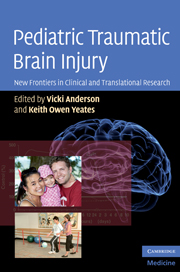Book contents
- Frontmatter
- Contents
- List of contributors
- Acknowledgments
- Introduction: Pediatric traumatic brain injury: New frontiers in clinical and translational research
- 1 Biomechanics of pediatric TBI
- 2 Neurobiology of TBI sustained during development
- 3 Using serum biomarkers to diagnose, assess, treat, and predict outcome after pediatric TBI
- 4 Clinical trials for pediatric TBI
- 5 Advanced neuroimaging techniques in children with traumatic brain injury
- 6 Neurobehavioral outcomes of pediatric mild traumatic brain injury
- 7 Very long-term neuropsychological and behavioral consequences of mild and complicated mild TBI: increased impact of pediatric versus adult TBI
- 8 Neurobehavioral outcomes of pediatric traumatic brain injury
- 9 Neuropsychological rehabilitation in children with traumatic brain injuries
- 10 Psychosocial interventions
- 11 Pediatric TBI: challenges for treatment and rehabilitation
- 12 Integrating multidisciplinary research for translation from the laboratory to the clinic
- Index
- Plate section
- References
3 - Using serum biomarkers to diagnose, assess, treat, and predict outcome after pediatric TBI
Published online by Cambridge University Press: 14 May 2010
- Frontmatter
- Contents
- List of contributors
- Acknowledgments
- Introduction: Pediatric traumatic brain injury: New frontiers in clinical and translational research
- 1 Biomechanics of pediatric TBI
- 2 Neurobiology of TBI sustained during development
- 3 Using serum biomarkers to diagnose, assess, treat, and predict outcome after pediatric TBI
- 4 Clinical trials for pediatric TBI
- 5 Advanced neuroimaging techniques in children with traumatic brain injury
- 6 Neurobehavioral outcomes of pediatric mild traumatic brain injury
- 7 Very long-term neuropsychological and behavioral consequences of mild and complicated mild TBI: increased impact of pediatric versus adult TBI
- 8 Neurobehavioral outcomes of pediatric traumatic brain injury
- 9 Neuropsychological rehabilitation in children with traumatic brain injuries
- 10 Psychosocial interventions
- 11 Pediatric TBI: challenges for treatment and rehabilitation
- 12 Integrating multidisciplinary research for translation from the laboratory to the clinic
- Index
- Plate section
- References
Summary
A biomarker is an objectively measured and evaluated characteristic which is an indicator of normal biologic processes, pathogenic processes, or pharmacologic responses to a therapeutic intervention (Group,2001). Physicians in clinical practice routinely use biomarkers to diagnose and assess disease severity, assist in disease prognosis, and evaluate treatment efficacy. Generally, injury and/or cell death results in increased concentrations of a given biomarker, either due to the release of that biomarker from the injured cell (e.g. creatine phosphokinase (CPK) in patients with myocardial infarction) or the lack of excretion of a normally excreted chemical which results in its accumulation (e.g. blood urea nitrogen in patients with renal failure). In some cases, however, a decrease in biomarker concentrations indicates pathology (e.g. haptoglobin in patients with hemolytic anemia).
Development of a clinically acceptable “brain” biomarker has proven much more difficult than the development of biomarkers for other organs. The difficulty is likely due to a combination of anatomic, physiologic, and technical issues. The complexity of the brain and the concomitant complexity of its response to injury have been barriers to development of sensitive and specific brain biomarkers. The presence of the blood–brain barrier which limits the amount and size of the biomarkers that can cross into the serum has also been an important issue. Until recently, technical difficulties had hindered the ability to identify novel candidate biomarkers using proteomics and, as a result, the number of potential biomarkers has been limited.
- Type
- Chapter
- Information
- Pediatric Traumatic Brain InjuryNew Frontiers in Clinical and Translational Research, pp. 36 - 53Publisher: Cambridge University PressPrint publication year: 2010
References
- 1
- Cited by



